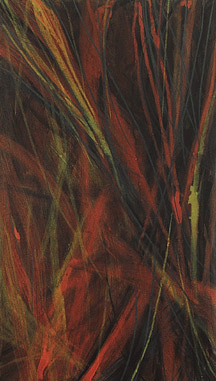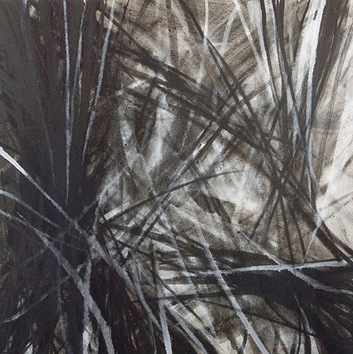Inventory of spaces, both spatial and temporal
by Moacir dos Anjos
(translated from Portuguese by Beatriz Viégas-Faria)
Published in the catalogue of the solo exhibition at the Fundação Joaquim Nabuco, Recife PE, 2000.
Removed from any ambition of representing the world which is exterior to them, Manoel Veiga’s paintings introspectively turn to the investigation and documentation of their own making. Coming from every side of the canvas, energetic lines and strokes made of charcoal and paint run, in apparent confusion, towards the heart of each and every one of his paintings, depositing on them a centripetal bundle of hot colors. However, this is no random or improvised achievement. While they do include and register, within the space defined by the canvas, the artist’s gesture of self-expression, these works of art follow a process of construction that subordinates that which is spontaneous to that which weaves signification, and subordinates the commendation of matter and form to cognitive procedures.
A close examination of the morphology of the paintings now on exhibition will reveal, from the very first look, the main characteristic of this process: the overlapping of countless layers of paint and charcoal on the canvases. This does not mean, however, that the more recently applied layers obliterate our view from those that were first printed in the canvas. Such palimpsestic effect is attained through the various constructive courses adopted by the artist. Among these, one such course that catches the eye is the gradual narrowing of the wide brush strokes of paint that commence each piece of work, to the point that, on the surface of the paintings, they become streaks rather than strokes, lines rather than areas of luminosity. At the more evident moments of thinning down the painted matter, the artist adds lines of charcoal to the painted canvas, thus accentuating the progressive paring down of what is left as material residue of every gesture of his. Although the pictorial spaces that initiate the paintings will allow – through this process, and once finished the paintings – their being covered by a tangled graphic mesh of both paint and charcoal lines, the structure is sufficiently rarefied not to obstruct the spaces that give origin to the paintings.
In another of his chief courses used in the construction of his paintings, the artist will seldom allow the brush to find the canvas while soaked in paint. The brush carries just the right amount of paint, so that, after its meeting roughly with the canvas, it makes visible the overlapping of planes the artist’s repeated gestures engender. Therefore, instead of thick and opaque matter, it is thin traces of paint left on the canvases that will mark, by means of glazing, the condensation of space on Manoel Veiga’s paintings. Moreover, the greater the accumulation of painted layers, the briefer and the more tenuous the contact between brush and canvas, emphasizing transparencies the little paint used had already predicted. And the charcoal used does not leave a deep mark either: with the artist’s quickly brandished blows, it touches the canvases just enough to penetrate the fibers superficially. Therefore, the intended measure of the thickness of the stroke or line thus produced seems to be that minimum space that happens when matter and canvas barely touch – within the limits of separation, yet granting the unequivocal record of their getting together.
Along this visible path from area to line, and across the growing transparency of matter applied to canvas – procedures that are the foundations of the construction of each piece of work on exhibition –, there resides an investigation of the temporality that is peculiar to painting and of the virtual spatiality of the surface upon which painting becomes gestated and defined. When they reveal, through their trespassable materiality, a mode of production in countless layers and in growing speed, these works of art display their own chronicle, the flowing of time that permits their existence as paintings. And, to the duration in time of this workmanship, until the precise moment when each piece of work is finished, a progressive dislocation of planes is associated, according to which layers already painted pull back and withdraw from the surface of the painting due to the accumulation of so many other layers. Imprinted as topics in Manoel Veiga’s paintings, one finds, therefore, not only the duration of the process through which the artist weaves them, but also the illusive and changeable extent of the spaces he invents on their surfaces.


